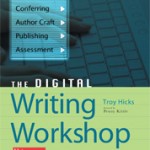“I don’t have anything to write about…” How many times have we all heard that?
Using a structure like “Writing Territories” provides a powerful way to start scribbling their ideas. These ideas can be listed or supported through collaborative conversation. This mini lesson (* are specific and allow time for students to share their samples to the class) provides ideas, places, deep memories to provide the “juice of life” to our choices of stories.
Another ‘mini lesson’ is IMAGERY (eg. ‘Show not Tell’ – uses detail, dialogue and appeals to the senses….) Mentor Texts can be used to support the writing process. They provide opportunity to see and play with models that can be applied in student’s own writing. Click here for a list of mentor texts to play with your classes.
- Read Chapter 3 – Digital Writing Workshop
- How do you support writers to move beyond the superficial? (Please leave a comment on the blog.)

This year we have focused a lot on developing organized paragraphs with a strong main idea and supporting details. We have talked about the supporting details as mini-stories or vignettes that make the ideas come alive for the reader. Encouraging the students to use sensory language in their supporting details has produced some exciting “word pictures” that elevate their writing beyond the superficial.
I am still working on knowing how to help students move beyond the superficial. I have provided choices of topics that are personal and allow them to write about things that matter to them. However, I found that still some students struggled and so I sat with them and asked them questions to probe their thinking. When they responded to my questions, I told them their thinking was interesting and to write it down. Now, I am trying to foster this questioning through peer exchanges and comments on our blog. Eventually, I’d also like to try Google Docs. I will try to model good questions readers can ask to push (lift) a writer’s thinking.
Developing and refining good questions is a technique that takes a lot of time and energy. I’ve found lots and lots of practice is key to moving forward. And of course a whole bunch of play with words and language.
I use a lot of dialogue before any writing happens in my classroom. I model, model, model, acknowledge strategies in the literature we’re reading (even if I am not doing a writing piece at the time, I always point out writing strategies)have students talk amongst themselves, jot ideas, add words that help them describe their ideas before they ever go and write. The planning/dialogue/model piece is always the major part of any writing assignment.
I think the best way to inspire students is to have a really good hook. It could be literature or a clip or some sort of topic that inspires them. Juicy discussions where the students share their ideas can help those that aren’t feeling as inspired. I have worked with my class on different ways to include details in writing with the assistance of good ol’ Adrienne Gear (triple scoop words, writing with trying to inspire your reader to visualize, using your 5 senses). I’m really excited to bring technology into the mix to hopefully inspire them to go beyond the superficial because they are so motivated by being able to use technology in different ways.
I’m excited about the technology too – how it’s used, where it’s used and how people see the connections with it. I think what you may be referring to is the engagement piece. The technology may present information in a variety of ways but ultimately it’s how we connect all the pieces to make it real is the power.
I think providing them different samples of writing that goes beyond the superficial will give them a sense of what this means. When I’ve shown them examples and pointed out exactly how it meets or exceeds expectations along with criteria to follow, they have been more successful. Also, providing them time to revisit the same piece of writing to make it move beyond the superficial gives them a chance to re-work their piece of writing. Pairing them up with others to work together can also help develop their writing in this way.
To help students go beyond the superficial, I usually show/ model this to them. I tell them a personal story about my life and show that I am risking that little bit with disclosing my personal feelings. This usually inspires a fair amount of students to dig deeper. Motivating all students to do this remains a challenge.
Just reading the responses above to give me a flavor, these are the things I do. I have lots of dialogues with students about writing and writing styles to communicate the context. We then look at examples of what the intended writing outcomes would look and sound like by making a T chart. What does persuasive writing looks like? what does writing to inform look like? etc.. They then brainstorm with ideas.
Thank you everyone for your thoughts. I’m very excited about this project of using Google Docs (and other forms of technologies) to support voice, writing, and collaboration.
~Jan